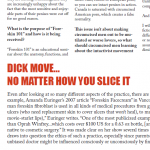By Joel Smart (The Cascade) – Email
Date Posted: September 21, 2011
Print Edition: September 14, 2011
View article in original print layout:





 There are a number of issues that can completely turn two intelligent, well-intentioned individuals against each other, and routine infant circumcision is one of them. So it is with great trepidation that I broach this topic, well aware of the emotions at stake. However, it has long been the case that universities have provided a haven for social activism and forward thinking. The circumcision of healthy children is the cause of a growing grassroots movement that seeks to clarify and eradicate the myths and misconceptions which propel the practice onward, while raising awareness of the importance of recognizing a child’s human right to bodily integrity.
There are a number of issues that can completely turn two intelligent, well-intentioned individuals against each other, and routine infant circumcision is one of them. So it is with great trepidation that I broach this topic, well aware of the emotions at stake. However, it has long been the case that universities have provided a haven for social activism and forward thinking. The circumcision of healthy children is the cause of a growing grassroots movement that seeks to clarify and eradicate the myths and misconceptions which propel the practice onward, while raising awareness of the importance of recognizing a child’s human right to bodily integrity.
In addition to the grassroots movement to end forced circumcision, which is especially strong in British Columbia, there has been an increasing amount of attention paid to the subject by the mainstream media. Russell Crowe was accused of being an anti-Semite over the summer for tweeting that he found the circumcision of infants “barbaric” despite the fact that he was tweeting the comments to his close Jewish friend, film director Eli Roth. Admittedly, it’s a pretty stark contrast from the last time a Hollywood actor made the news for talking about circumcision. In 2010, Sandra Bullock told People magazine that witnessing her son’s genital cutting was “the greatest moment I have ever had in my life.” If you say so, Sandra!
Circumcision also made the news over the summer when a community-initiated bill in San Francisco, which would ban elective circumcisions on children under 18, collected more than the 7500 signatures required to land it on the November ballot. In just the last couple of weeks the bill was thrown off the ballot, as a judge decided it fit within criteria of a medical procedure, which cannot be banned on a city-to-city basis. Even more recently, advocacy groups that formed to fight the circumcision ban submitted their own bill which would give the practice of circumcision special protection under the law. On August 23, a California Senate committee unanimously approved the bill.
I asked San Francisco resident Lloyd Schofield, who led the original circumcision ban effort, what students reading this story should make of the situation. His response emphasized the importance of critical research and the recognition of human rights. “I would say study the issue, look at the facts and stand up for genital integrity for all people,” he said. “It is a basic human rights issue and affects society as a whole even if it doesn’t affect you personally.”
But this is a complex issue that can’t be explained by the legal system or by Hollywood. Circumcision is still common in our culture because of a lot of different reasons: people have heard that it’s cleaner and healthier, that a child won’t be normal or accepted if he isn’t circumcised, and that it is of critical importance to a son’s psyche that his penis is an exact visual match to his father. So instead of telling you more about how celebrities like Mario Lopez, Joe Rogan and radio host Howard Stern are speaking out against circumcision, this feature story will address those concerns and share some of the information I’ve learned as I’ve researched this issue for academic papers and spoken with local activists about why they do what they do.
KEY FACTORS
Idea: Circumcision is so common, there must be a good reason for it.
The true origins of circumcision are seemingly lost in antiquity, although many theories exist. However, in America, non-religious circumcision became popularized only in the mid-1800s during the highly puritanical Victorian era. Although there are many ideas as to why the practice is done today, the original motivation was to prevent children from masturbating (which was called self-abuse at the time, due to the belief that it caused disease, insanity and death).
Dr. John Harvey Kellogg, inventor of Corn Flakes, exemplifies the mindset of the time when he wrote in his book: “A remedy for masturbation which is almost always successful in small boys is circumcision… The operation should be performed by a surgeon without administering anaesthetic, as the pain attending the operation will have a salutary effect upon the mind, especially if it be connected with the idea of punishment.”
Since that time, numerous “studies” looking for new “possible” benefits of circumcision, usually once the last reason had been disproved. Circumcision was said to prevent everything from bed wetting to clubfoot. Female genital cutting was also common at the time, for similar reasons, and was even covered by Blue Cross-Blue Shield medical insurance until 1977.
Idea: I’ve heard it’s recommended for health reasons.
No national medical organization in the world recommends circumcision, including the American Academy of Pediatrics and the Canadian Pediatric Society. The College of Physicians and Surgeons of British Columbia is responsible for training, licensing and informing the physicians and surgeons in our province. To that end, they have an extremely clear statement regarding infant circumcision:
Advise parents that the current medical consensus is that routine infant male circumcision is not a recommended procedure; it is non-therapeutic and has no medical prophylactic basis; it is a cosmetic surgical procedure; current evidence indicates that previously-thought prophylactic public health benefits do not outweigh the potential risks.
The aforementioned risks are certainly not minor either. There are numerous examples, even within the last year, of children dying from circumcision, even in sterile hospitals in North America with trained practitioners. One study estimates that within the United States, there are approximately 117 annual circumcision-related deaths. There are also numerous possible complications from bleeding and infection, to adhesions and penile necrosis. It is estimated that meatal stenosis, damage to the urethral opening due to its permanent exposure after circumcision, is the most common complication, effecting 9-10 per cent of circumcised boys.
Idea: It’s too hard to clean a penis that isn’t circumcised.
The foreskin is attached to the head of the penis at birth, and so the proper way to clean it is to simply leave it alone – wash it like a finger. With everything going on in the first days of being a mother, trying to care for an open wound in a dirty diaper is a far more difficult task, especially with the risk of bleeding so dangerous in small children with almost no blood to spare.
A foreskin can naturally become retractable from just a few years old to puberty, and it is normal either way. Only the child should check this, as forcing the foreskin back can cause problems. Once he can pull back his foreskin, he just needs to pull it back and rinse with water.
Not only is it perhaps the easiest form of hygiene, it’s probably the one thing you can count on your son cleaning in the shower. Comparatively, brushing your teeth is like rocket science, requiring fancy tools and creams.
Many people are afraid of smegma, a substance that can develop under the foreskin. Little do they realize, the folds of the female genitals develop the exact same substance, and it is known to have antibacterial properties.
Idea: The foreskin is a bit of extra, useless skin – nothing he’ll miss.
The foreskin is a highly-specialized structure made up of several parts, including an inner and outer layer of mobile tissue, and according to a 2007 study published in the British Journal of Urology, it contains the five areas of the penis most sensitive to fine-touch: “Circumcision removes the most sensitive parts of the penis and decreases the fine-touch pressure sensitivity of glans penis.”
In fact, the foreskin contains nerve endings like those found in the fingertips and lips. One interesting exercise is to lightly rub the back of your hand and then your palm. If you notice that your palm feels more sensitive and tickly, that’s a result of nerve endings called Meissner’s corpuscles; the foreskin is packed with them.
The foreskin also has protective and sexual functions, largely do to its ability to move back and forth. Violet Hart will cover the sexual in her column, but protectively, the foreskin mimics the functions of the clitoral hood and the labia minora: it protects the head of the penis (as the hood protects the head of the clitoris), and the urinary/reproductive tract and meatus (as the labia minora do). Only a single enzyme (21-hydroxlase) in the womb determines if the uro-genital folds develop into the foreskin or the labia minora and hood.
Idea: The foreskin is just plain unsightly. If it isn’t removed he’ll never be normal.
That a circumcised penis looks better is a pretty subjective opinion, but one that people are free to have. But, let’s pick any other normal, sensitive, functional part of the body and see if a parent’s aesthetic preferences count as a valid indication for surgical removal.
The vast majority of the world does not practice infant circumcision, and the general consensus seems to be that people prefer what they are raised to see as normal. Since no province in Canada funds circumcision anymore, the rates have dropped significantly. Many hospitals and individual physicians have since stopped performing the procedure. Since the majority of boys are not circumcised in Canada any longer, it is a good bet that future generations will not grow up to see the circumcised penis as the “norm” the way it was previously seen.
Regardless, it’s worth noting that few children (if any) will ever feel “normal”. Some will have different features than their friends or find some reason to feel insecure. We should teach our children that being different is okay. Removing part of their genitalia to help them fit in sends the opposite message.
Idea: I should circumcise my child because my religion tells me to.
Although this is a situation many Jewish and Muslim families face, many Christians also feel obligated. However, the New Testament specifically discourages the practice. For example, Galatians 5:5-6 reads, “For in Christ Jesus, neither circumcision nor uncircumcision has any value. The only thing that counts is faith expressing itself through love.”
A great number of religious and cultural practices have been discouraged as increased importance is given to individual human rights. For example, Canadian law protects children from undergoing traditional scarification practices, foot binding or any kind of religious ceremony involving female genital cutting. In a 2009 Pediatric Anesthesia article, Tim Dare explained: “…religious tolerance, understood as a right for autonomous adults to practice the religion of their choice, can also justify a restriction on those religious practices which would rob the child of their own chance to become an adult possessing such a right.” Religious freedom is the right to choose for yourself.
There are a growing number of Jewish and Muslim groups pushing for change among their fellow believers. A revised Jewish ceremony without the genital cutting, called a Brit Shalom, is gaining popularity.
Idea: He’s a man, he can take it. He won’t remember. He should look like his dad.
Until very recently, anesthesia was never used during circumcision. In many cases, it still isn’t. Truthfully, infants cannot be given adequate pain relief during a circumcision anyway, as it is too risky. An infant also has no concept of time passing or healing, and many go into a form of shock due to the pain. One study found that cortisol (stress) levels spiked in infants being circumcised to a degree found in adults undergoing torture. Another study, done on an infant circumcised in an MRI machine, found that areas of the brain most intensely affected were “associated with reasoning, perception and emotions.” Permanent change in the brain was also indicated.
The pain is very real, and very difficult for such a young, vulnerable child to handle. Remembering pain isn’t what is so bad, it’s those moments of actually experiencing it.
It is so much easier to simply tell a child that their father had an operation done that thankfully they didn’t need, than it is to subject a child to surgery. Kids don’t generally spend a lot of time looking at the genitals of their parents anyway, and they’re going to be drastically different in size and other features to boot.
For Skin: Why we love the turtle
By Violet Hart (The Cascade)Evolution isn’t perfect. There are lots of things we don’t seem to need: wisdom teeth, appendixes, tonsils. But if there’s one area I don’t think we should fuck around with, it’s probably our genitals. In fact, one wonders who thought cutting off pieces of our genitals was a good idea in the first place, especially considering that both male and female circumcision were being practiced long before anesthesia.
We all agree that female circumcision is barbaric and just downright cruel to women. However, thanks to tradition – one which, in the Western world, is actually not more than a century old, with the exception, of course, of the Jewish community – most think that male circumcision is not only normal, but healthier, esthetically pleasing and, well, preferable.
The fact of the matter is that circumcision is far from normal. Does it not occur to anyone that we are slicing off a significant portion of a guy’s dick? That’s so uncool. And don’t think for a second that the foreskin isn’t an important part of the penis. In fact, it’s the best part. Why? Because it’s the part with most of the sensation. That’s right, nearly all of the male fine-touch neuroreceptors are removed by circumcision.
Many men feel uncomfortable and scoff when they are told this. Which is understandable, no man wants to feel like his tool is damaged, or second-rate. Well, it isn’t necessarily. He can still enjoy sex. He certainly has the same sex drive and ability to ejaculate and become erect (although circumcised men can’t stay erect as long). But is he missing out? The sad truth is yes. Chop off half a woman’s clitoris, and she’ll miss out too. The moral of this story is not to chop off parts.
Now, removing the foreskin doesn’t only affect the man’s pleasure. It affects women just as much, if not more. The foreskin plays an important role in maintaining a smoother, more sensual sexual experience for a man’s partner. Because circumcision removes most if not all of the moving parts of a penis, intercourse becomes more abrasive to the delicate walls of the vagina or anus.
Additionally, the ridge of the head of the penis has been shown to draw out a significant amount of lubrication on each stroke, which increases the chance of painful sex. In contrast, this lubricant is captured by the foreskin, which recovers the head as it pulls out. This recovering action of the foreskin actually causes this sealed-in lubrication to be evenly distributed over the head of the penis, which keeps sex wetter for longer (and wetter is always better!). This problem only gets worse for women as they age, as their vaginal walls become thinner and more prone to tearing – not to mention they naturally produce less lubrication as they approach menopause.
Worse than all of this is that circumcised men need to fuck harder to get pleasure. His remaining pleasurable nerves are pressure nerve endings, and thus the man must pound his dick into the poor girl in a way that is less than enjoyable for her. Taking such long thrusts means that his pubic area isn’t making consistent contact with her clitoris, which can keep her from orgasm; also the jolting, uneven rhythm of being violently banged makes it more difficult for her to come. No wonder so many women complain they can’t orgasm during sex. The vibrator industry, however, is not complaining. One study suggested that women are 85% more likely to experience orgasm with an intact partner, and that women prefer sex with intact men by a ratio of 8.6 to 1.
Men, I’m sorry if it’s too late for you, but this isn’t just about bemoaning what is lost. It’s important to realize that if you’re circumcised, you need to compensate for your lost foreskin. Use more lube, and reapply. Make sure she/he is satisfied, and try to lay off the rough banging. Most importantly, though, for both men and women, is to NEVER DO THIS TO YOUR SON. It’s time we stop perpetuating male genital mutilation. After all, sex is one of the best things we can have. Why fuck with it?
An interview with Vancouver Physician Rob Tarzwell
Rob Tarzwell, Staff Physician at St. Paul’s Hospital and former UFV student (then known as Fraser Valley College), was the host presenter at the Centre for Inquiry circumcision discussion at Simon Fraser University’s downtown location last month. With about 30 people in attendance he made a short presentation on circumcision and then facilitated discussion. Rob also works at Lion’s Gate Hospital and is on the faculty of medicine at the University of British Columbia.
With a lot of media coverage about circumcision as a prevention tool for HIV in Africa, I sat down with Rob to discuss the issue. We discussed how the history of circumcision in North America features a lot of attempts to find benefits for the practice. Rob suggested that maybe the reason so much effort and money is being spent on campaigns to circumcise Africa is simply that it is in a cultural blindspot. “If you have a ‘Circumcision, what’s the big deal?’ perspective, you’re perhaps more open to consider it if there’s a problem ‘solved’ by it… I think another very common notion when it comes to male circumcision is, ‘Meh…We’ve always done it this way.’”
We also discussed how difficult quality research would actually be. “In sex studies it is especially hard to do good science, because people are generally inhibited to report their behaviour in a completely factual way. Threats to valid research are always present but perhaps more so in sex research. Particularly when the stakes are so high,” he said. “There’s no way to do a double-blind study involving circumcision! And of course, biases, money, cultural blindspots, religious agendas rapidly intrude.” He also noted how what the research has really shown is that promoting condom use would be a much better use of HIV campaigns. “I mean, the question had scientific legitimacy, but we basically have the answer now: condoms are vastly more effective.”
Rob and I also talked about some of the unspoken psychology that could be behind some of the efforts to circumcise African men. “There’s something both convenient and yet also infantilizing in this idea of circumcision as the magic HIV bullet,” he said. “It’s almost as if the promoters want it to be some kind of condom you never have to actually put on…there’s an aspect of saying, ‘You won’t behave responsibly, so we’re going to modify you so your behaviour won’t matter.’ I bet nobody is advocating circumcision in South America, or the US specifically for HIV. There’s no way that message would be tolerated, and public health officials would be too embarrassed to offer it.” Rob did clarify though, that he wasn’t an expert on the situation in Africa, and that certain factors could be at play. “There have been some really weird ideas about HIV in Africa, and there may be factors in the field that we are simply unaware of. For instance, I don’t know how strong Catholic anti-condom propaganda is at actively discouraging use. Or whether condoms are in some way tribally unacceptable…I have no idea. It’s really complex.”
UFV professor Jenea Tellentire on circumcision
Jenea Tellentire, a UFV professor who teaches Women’s Studies, spoke with me at length about the shifting cultural attitudes towards circumcision, the feminist perspective on the issue and the importance of informed consent. Her experience studying and teaching gender issues in the Fraser Valley makes her a valuable asset in understanding the current framework that surrounds the issue in our area.
Tellentire recently visited a hospital in Vancouver where the practice is no longer performed. “In my recent tour of the delivery unit at Royal Columbian Hospital, the nurse running the tour was very firm that it was an elective procedure – a cosmetic surgery, in fact – and told us that you had to find a private clinic to do it, for pay,” she said. “She really made it out to be something that was not normal anymore, and not something people should think about if they didn’t have a particular reason like religion to consider it – but regardless, it was out of the hospital’s hands. Not their business, or responsibility, in short. Which is quite the opposite of the past, when it was routinely offered and performed.”
“This new message is I think a good one,” Tellentire said, impressed by the hospital’s stance. “This preserves the ability of parents to pursue circumcision for cultural reasons, while eliminating the element of coercion on the part of medical staff or new parents who might normally not have any cultural reasons for doing it, and who are often unprepared or simply too weary to question anything staff puts forward as ‘necessary’ or ‘for your baby’s health.’ Believe me, that is extremely powerful, especially within a few hours after birth.” Because the practice is now defined as cosmetic surgery, it means that a lot of people need to reframe their understanding of the practice and its purpose. It also means those who wouldn’t traditionally circumcise aren’t sucked into debates about extremely minimal, hypothetical benefits. “Thinking of this as cosmetic surgery is interesting and especially useful when we’re not talking about parents from cultures that view circumcision as a religious/cultural expression,” Tellentire said. “Though if it is entirely for religious/cultural reasons, then it would [still] fit the definition of ‘cosmetic’ as well – not medical.”
Feminist theorists differ on their stance towards male infant circumcision. While some are preoccupied with ensuring the practice is not directly compared with female genital cutting and the additional gender discrimination women face in cultures that practice it, others feminists see circumcision as an issue that feminists should care about. “Some have issues when commentators try to portray male and female circumcision as equivalent, pointing out, for example, that the equivalent of clitoridectomy would be amputation of most of the penis,” Tellentire said. “However that doesn’t mean male circumcision shouldn’t be considered.” She notes how an article published in Australian Feminist Studies called “Foreskin is a Feminist Issue” explains how “the reasoning for female circumcision in Africa” has a “striking resemblance” to reasons male circumcision is performed. A similar article written by feminist scholar Hanny Lightfoot-Klein actually illustrates some of these similar reasons, ranging from aesthetics, family tradition, normalcy, hygiene and a misunderstanding of the value of the tissue being removed. “If the attention to female circumcision and its widespread condemnation from the UN down can help us open the question of whether male circumcision is necessary or right, then that’s good,” Tellentire said. However, she felt that rather than comparing whether the issue is the same, a better idea is simply to do a “straight-on look at what male circumcision means, and for our purposes looking right here in North America and BC.” To do that from a feminist perspective, Tellentire suggested asking two questions: “why male circumcision is done, and whether it is ethical.”
To answer the question of why circumcision is done, she shed some light on the mindset of the people who popularized the practice. “In the early 20th century, masturbation was considered a serious problem that would permanently weaken a boy and man physically, as well as morally and spiritually,” Tellentire said. “Circumcision [was thought to] help curb that ‘shameful tendency’. As well, the desensitization effect of circumcision would help curb male sexuality, sexual excess, even sex crimes – they were working with a ‘volcano’ model of male sexuality where it was seen as sort of an inevitable force that could become uncontrollable, so things like ‘taming’ the genitals would help.” Though reasons for the practice vary today, none seem to hold weight in cultures where the practice is not already the norm.
The second question Tellentire set out to answer proved to be much more complex. “It’s a classic ethical conundrum: it is wrong to alter bodies without or against the person’s consent,” she said. “Yet as many feminists point out, control of one’s own body is a clear feminist issue. That control can be argued to extend to body modifications such as piercing, tattoos, cosmetic surgery, scarification, etc.” She then pointed out how many feminists stress individual agency. “Thus, many feminists would say elective body modification in adulthood is okay, with informed consent.”
“Informed consent is the kicker,” she said. “Coercion then becomes the central issue. This could appear in the form of medical or cultural authorities pushing the practice as necessary or required, with threats of medical, moral, or social consequences,. Or general ideas floating around about ‘being the same as other men’ or that it makes men ‘perform better sexually.’ Or most simply, fears of ‘not being normal.’ These different pressures damage people’s capacity to get full information or make a freely-chosen decision. So it seems to follow that an adult male should be able to elect for such a surgery if he felt it necessary or desirable, as long as it was done with full informed consent of the risks, effects, and awareness of the differing pressures that might lead him to want such a procedure. (That last bit is the trickiest). Then he can weigh the pros and cons.”
“So the hospital’s stance of declaring it an elective cosmetic surgery and not offering the procedure themselves is a good step, yet still allowing for people really committed to cultural practices. As the article ‘Foreskin is a Feminist Issue’ notes, in some countries like the UK and New Zealand, the numbers have drastically fallen from early and mid 20th C – NZ is less than 2 per cent now. So the role of the hospital/medical profession was obviously huge and now has a major effect in ending the practice.”
An interview with the founder of CAN-FAP
Vancouver has a number of internationally-known intactivists, but perhaps the best known is the hilarious, but genuine Glen Callender, founder of the Canadian Foreskin Awareness Project (CAN-FAP). Glen is a Vancouver-based writer and the senior arts and entertainment editor at UQ Events. At the time of this interview with The Cascade, which took place back in April, Glen was running an informative seminar called Foreskin 101. However, since that time, he has taken his show on the road with his lovely assistant Jennifer Campagnolo, doing demonstrations at Whistler Pride, Car Free Day in Vancouver, San Francisco Pride, Vancouver Pride, Edmonton Fringe, and most recently Davie Day in Vancouver on September 10.
Why should university students care about this issue, especially if they aren’t having kids yet?
University students should care because they will probably have kids someday, and the last thing anyone wants to do is hurt their child. From my perspective, university students are an ideal group to talk to, precisely because most of them haven’t had kids yet. People who have already cut their sons are much harder to reach, because it’s difficult for any parent to face the fact that they have sexually mutilated their child — even though they thought they were doing the right thing at the time.
Why is this such a hot-button issue in Vancouver?
B.C. is one of the least circumcised provinces in Canada, partly because B.C.’s Medicare program was the first to stop paying for circumcisions (in 1984). Today less than 10 per cent of B.C. boys are circumcised, and now that they are in the minority, young circumcised men are realizing that they are missing something, and they are increasingly unhappy about the fact that the most sensitive and enjoyable parts of their penises were cut off for no good reason.
What is the purpose of “Foreskin 101” and how is it being received?
“Foreskin 101” is an educational seminar about the anatomy, functions, and pleasure potential of the intact penis.
Using my own penis and some multimedia materials, I demonstrate how to achieve several different types of orgasm — including the elusive male multiple orgasm — by stimulating different areas of the inner foreskin. I think of “Foreskin 101” as my revenge against the B.C. sex ed curriculum, because when I went through sex ed in the 1980s, there was no foreskin on the diagram of the penis in the textbook. As a result of this horrible failure to educate people about foreskin, many people today still swallow the BS line that foreskin is just vestigial “extra skin” that doesn’t really matter to a man’s sexual pleasure. In fact, the inner foreskin is by far the most sensitive and orgasmic part of the penis, and I can prove it.
As for how the seminar is being received, I’ve presented it three times so far and the response has been tremendously positive — I’ve been getting rave reviews from circumcised men, intact men and women alike. Eventually I’ll be putting the material online so every Canadian can have access to it from the comfort of their home.
If a woman (or man) finds that, seemingly against her own will, she finds a penis with foreskin less appealing than the variety she’s used to, what should she do? What is the solution?
Hatred of foreskin is like hatred of black cats: it is 100 per cent learned. If you have been “educated” to dislike foreskin, counter that by educating yourself about what foreskin truly is and what it does. When you know what the foreskin actually is and what its benefits are for both the man and woman — and there are many benefits — you’ll appreciate it a lot more. Also, switch to European porn, so you can see intact penises in action. Canada is saturated with circumcised American porn, which creates a false normality.
This issue isn’t about making circumcised men out to be mutilated or worse lovers, so what should circumcised men learning about the intactivist movement keep in mind?
Actually, this issue is partly about informing circumcised men that they are indeed mutilated — they are missing more than half of their penile nerves (including the five most sensitive parts of their penises) and approximately half of their penile skin (including the critical, nerve rich inner mucous membranes, which reduce friction on both the penis and vagina during intercourse). What’s worse, everything that is exposed by the missing foreskin is gradually building up a thicker and thicker layer of scar tissue and losing even more sensitivity. Men circumcised in infancy will live their entire lives never once knowing how sex is supposed to feel. Their bodies and erotic lives have been arbitrarily censored, and it’s impossible to completely repair the damage.
And that’s a tragedy.
I will not perpetuate the ridiculous fiction that it really doesn’t make any difference if a man is circumcised or not, because giving cut men false assurances that their penises are not diminished leads to more baby boys being cut. Most circumcised men today are leaving their sons intact because they know that circumcision is harmful and unnecessary, and I am dedicated to continuing that trend, not undermining it.
Circumcised men learning about the intactivist movement should keep in mind that intactivists are not against circumcision per se: we have no objection to consenting adults modifying their bodies as they see fit. We are opposed to circumcision being forced upon children. This really isn’t about circumcised men, because, unfortunately, it’s too late for them. It’s about protecting the children yet to be born.
Circumcised men should also understand that intactivists are not attacking their penises: that is what the person with the knife did. Ironically, we are actually defending their penises, or more accurately, defending the penises they were born with.
We assert that circumcised men were perfect and healthy and normal when they were born: their penises were not deformed, ugly, or unhygienic. Their penises did not require urgent surgical correction. Over 80 percent of the men on this planet have their foreskin, they are perfectly healthy, and they are not complaining. These are the realities that every cut man must face, because it is of vital importance that, should they have a son, they break the cycle and leave him intact so he can live his sex life to the fullest.
What’s the best thing about having a foreskin?
In my case, the extremely intense multiple orgasms. At the seminar I show a video clip of me having five orgasms — including ejaculations — within five minutes, all without touching the head of my penis or “jerking” my hand up and down the shaft. All I’m doing is lightly massaging my inner foreskin! I’ll be putting a “multiple foregasm” demonstration video up on the CAN-FAP web site later this year — believe me, it’s the wank video every Canadian should see.
How can people get involved?
On a personal level, have a serious discussion with anyone you know who is expecting a baby boy. It may be a sensitive subject, but it’s a vitally important issue because kids being cut today will live most of their lives in a very different world — a world where foreskin is respected, protected and even admired — and they will be much angrier about their circumcisions than men of previous generations.
Second, if there isn’t an intactivist group on your campus, start one. It’s time for Canadian youth to get active on this issue, because there will be a fight over this, just like there were fights for queer equality, women’s reproductive freedom, and the rest. Canadian males will not truly have sexual freedom so long as other people have the right to arbitrarily amputate their sex organs. The right to a whole body is a basic human right, and yes, it’s worth fighting for.
For those interested in getting involved, ‘Like’ the CAN-FAP page on Facebook to stay in the loop about upcoming CAN-FAP events.
DICK MOVE…
NO MATTER HOW YOU SLICE IT
Even after looking at so many different aspects of the practice, there are many things about circumcision that this feature simply didn’t have space to discuss. Take, for example, Amanda Euringer’s 2007 article “Foreskin Facecream” in Vancouver’s The Tyee, which she questioned the ethics of infant foreskins being sold for profit. “Human foreskin fibroblast is used in all kinds of medical procedures from growing skin for burn victims and for eyelid replacement, to growing skin for those with diabetic ulcers (who need replacement skin to cover ulcers that won’t heal), to making creams and collagens in the cosmetics industry (yes, the product that is injected into puffy movie-starlet lips),” Euringer writes. “One of the most publicized examples of the foreskin-for-sale trend involves a skin cream that has been promoted by none other than Oprah Winfrey…which costs over $100 US for a 0.63 oz bottle, [and] is used by many high-profile celebrities (such as Winfrey and Barbara Walters) as an alternative to cosmetic surgery.” It was made clear on her show several times and on her website that the cream was “engineered from human foreskin!” Euringer’s article draws into question the ethics of such a practice, especially since parents are often not informed that their children’s body parts are being sold, or that the supposedly unbiased doctor might be influenced consciously or unconsciously by financial motivations.
But times are changing, and people now have access to research they didn’t before. On August 26, the Canadian University Press newswire published a great article, originally published in Wilfrid Laurier University’s student newspaper The Cord entitled “In defence of foreskins.” In the article, Amelia Calbry-Muzyka argues that “…a male should be entitled to protection from harmful religious acts and unnecessary medical practices he cannot consent to…just because a practice is traditional, it is not necessarily right.”
Even within Orthodox Judaism there is a growing need to question the ethics of removing a valuable part of a child’s body without their consent. Eliyahu Ungar-Sargon is an Orthodox Jew who struggled with the issue. He decided to make a full-fledged documentary on the topic, as he interviewed family, friends, rabbis, doctors, and more. The film, Cut: Slicing Through The Myths Of Circumcision is now available in an abridged form for free on YouTube. Eli is currently on tour, taking the film across the United States and Canada, speaking with audience members after the film. It’s a powerful documentary, and will have a Vancouver showing on October 24. For more information about the showing, or other local “intactivist” events and news, check out the Facebook group Greater Vancouver Intactivists at their Facebook page.





